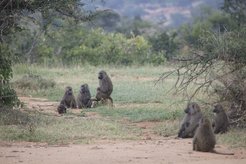Sleeping in Groups
Sleep is an inherently risky behavioral state, defined by decreased sensitivity to environmental stimuli. Sleeping together with other individuals offers a variety of advantages, including protection from predators and buffering against cold nighttime temperatures. However, group members also compete with each other over access to the safest, warmest, most comfortable sleeping spots, or the chance to sleep next to their preferred co-sleeping partners. Decisions about where to sleep are important, but assessing the options is complicated: the availability and quality of each position within the sleep site depends on the choices made by other group members.

To understand how group-living animals make complex, socially-contingent decisions, we use thermal tracking, as well as accelerometry—animals FitBits, if you will—to investigate how wild olive baboons incorporate environmental and social factors into their choices about where to sleep, and how these decisions impact the quality of their sleep.

Olive baboons live in stable multi-male, multi-female groups, that range in size from ten up to one hundred or more members. Within the group, baboons form highly differentiated social relationships, centered around kinship, affiliation and dominance. They live in a wide range of terrestrial habitats, from open savannah to closed tropical forests, but spend their nights sleeping in trees or on cliffs.
Baboons are most vulnerable to predators—particularly leopards—at night. To reduce this risk, troops sleep in trees or on cliffs, selecting perches that are difficult for predators to access. While predation risk may heavily influence individuals’ choices about where to sleep, it is far from their only consideration. By studying how baboons choose where to sleep, we aim to understand how animals navigate complex and multi-dimensional decisions that both influence and are influenced by the decisions of their group-mates.
Although all animals sleep, we understand remarkably little about it. Most research on sleep is conducted in sleep laboratories, disconnected from its natural context. In this project, we have the exciting opportunity to study sleep in a real setting. It gives insight into collective sleep behavior and how this shapes complex social systems.
Where to sleep

As night starts to fall, a group of baboons arrives at one of their usual sleep sites. Upon entering the sleep site, they must weigh a number of factors in deciding where to settle down for the night. This is when the scurrying starts and, as observers, we can imagine them thinking: ‘Is this branch stable? Am I likely to fall? Is this ledge better protected from the wind and rain? Or from predators who might try to eat me in my sleep?’
Multiple physical features of the sleep site may be incorporated into the baboons’ evaluation of its quality; temperature, cover from the elements, stability of the substrate, and accessibility to predators are all important aspects when choosing a sleep spot. By using 3D laser scans, we can reconstruct the sleep site and measure many of these parameters. At night, we track individuals using thermal cameras, mapping where group members move and how they navigate this complicated decision-making landscape. Collaboration with scientists in the Department of Collective Behavior to develop Computer Vision Models allows us to automate this tracking process.
Whom to sleep with
In addition to the physical characteristics of sleep sites, social factors likely play a large role in baboons’ decisions about where to sleep. Is my family close-by? Can I co-sleep with one of my preferred social partners? Might I be displaced by a dominant group member? All of these considerations combine to create a complex decision-making task. To add more complexity: each decision is influenced by choices of other group members, whose decisions are influenced by yet other individuals…
We expect that the social environment maps onto the physical environment, creating a constantly evolving decision-making landscape that updates every time members of the group make a decision or change their mind. Our goal is to understand how individuals navigate this complicated collective decision-making process, and disentangle how individual characteristics, social relationships, and decision-making dynamics interact to affect where baboons sleep.
To tackle this complex social problem, we have characterized the dominance, affiliative, and kin relationships of group-mates using genetics and direct behavioral observations supplemented by long-term data of our collaborator Dr. Matsumoto-Oda. We are implementing innovative analytical techniques that draw upon tools from social network analysis to understand how these social dynamics shape decision-making.
We let the baboons tell us where they prefer to sleep via their choices, and by quantifying both the physical characteristics and social qualities associated with these preferred sleep spots, we can determine which parameters drive baboon decisions. Further, we can assess how good these decisions are by monitoring individual sleep quality—an important determinant of health in primates.
Because an individual’s ability to negotiate a preferred sleep spot has quantifiable consequences, this presents an exciting opportunity to explore both the mechanisms, as well as the consequences, of collective decision-making.
Further reading & Cited articles
Blood Biochemical Reference Intervals for Free-Ranging Olive Baboons (Papio anubis) in Kenya





















